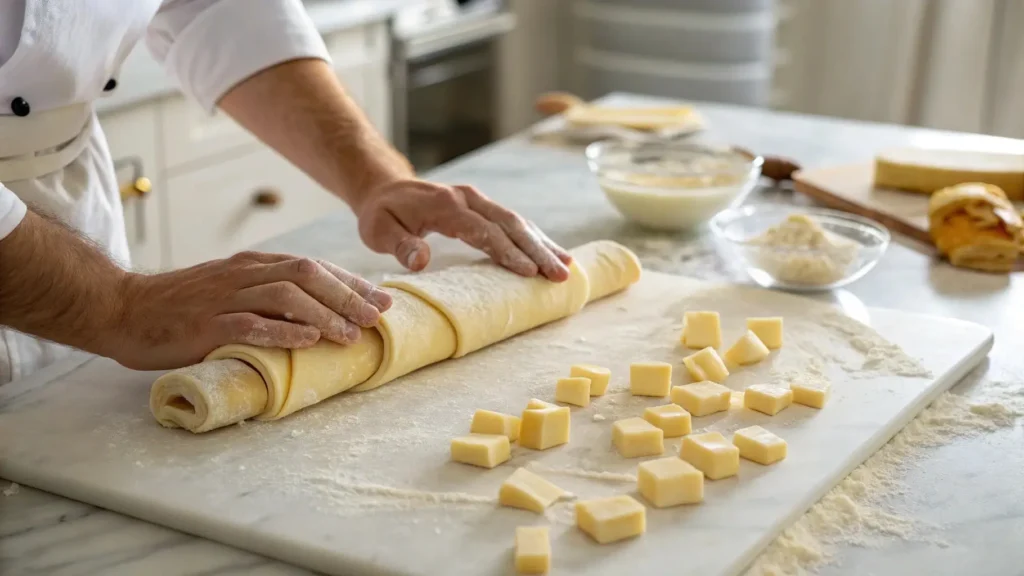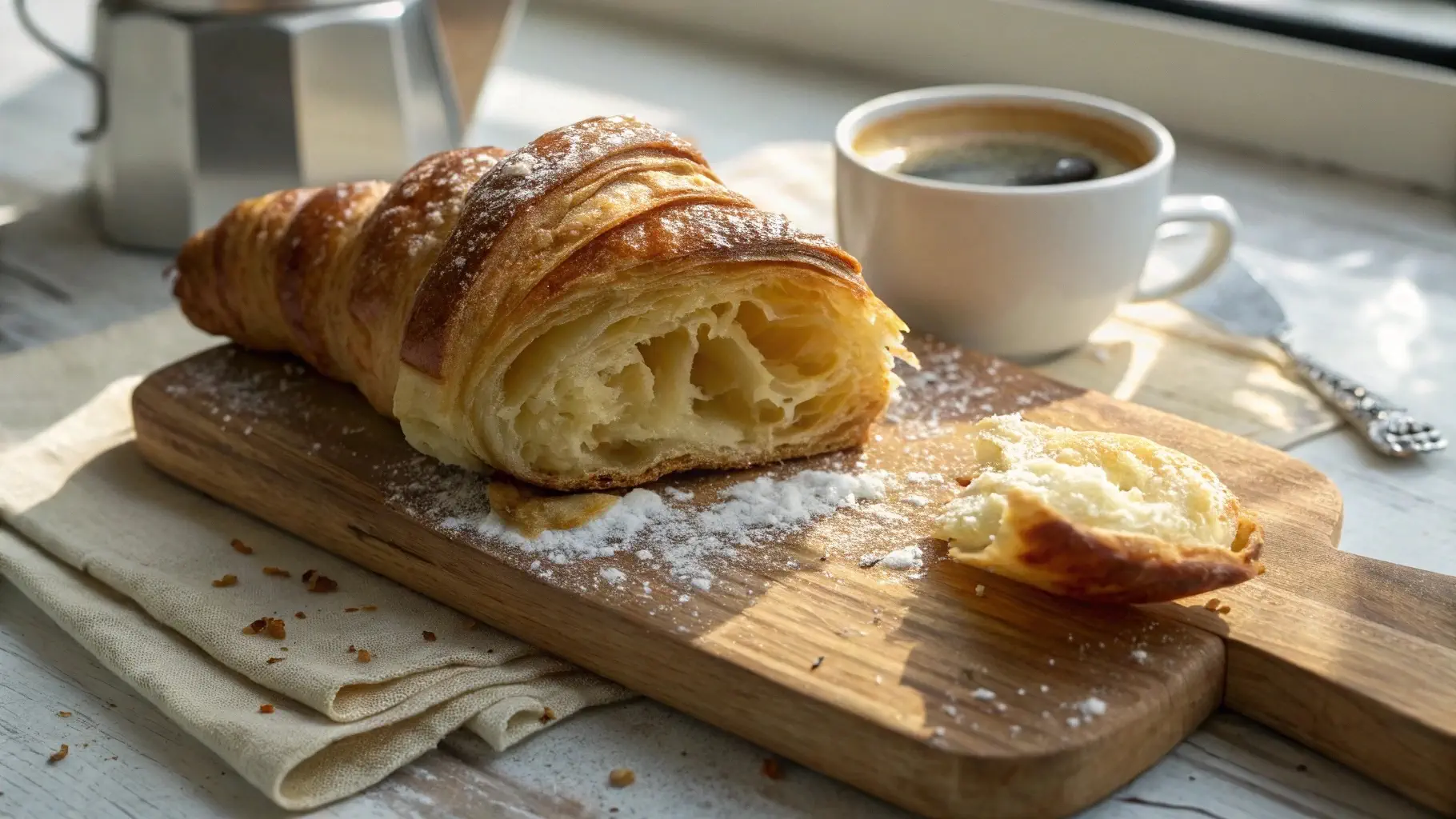Introduction to Croissants and Their Popularity
Croissants are the golden, buttery, flaky pastries that have become an essential part of breakfast tables and cafés all around the world. But while they seem simple to make, what is a common mistake in croissants? There’s more to these flaky delights than meets the eye. Whether you’re a seasoned baker or just someone who loves them fresh from the oven, croissants can be tricky to perfect. Let’s break it down and talk about why these pastries are so beloved—and where we tend to go wrong in making them.
Table of Contents
The History of Croissants
Okay, so before we talk about the common mistake in croissants, let’s take a quick look back at their history. Believe it or not, the croissant’s roots aren’t entirely French. It actually traces back to Vienna, Austria, where it was created to celebrate the defeat of the Ottoman Empire (yes, a bit of history in your pastry!).
The original crescent-shaped pastry was known as a kipferl. It wasn’t until the 19th century when French bakers perfected it into the buttery, flaky treat we recognize today. It wasn’t just about the flavor; it was the texture that made the croissant stand out. Understanding this history can help us appreciate how even the smallest mistakes in making croissants can affect their final texture and taste.
Why Croissants are Loved Worldwide
There’s something universally irresistible about croissants. Maybe it’s the soft, pillowy inside or the crunchy, golden-brown crust. Whether it’s at a café in Paris, a bakery in New York, or a local coffee shop in Tokyo, croissants have that magic ability to bring people together over breakfast or brunch. They’re versatile too—served plain, filled with chocolate or almond paste, or even stuffed with savory goodies. People can’t seem to get enough of them, and it’s not just about the taste. Croissants symbolize comfort, indulgence, and that perfect moment when you sip your coffee and bite into something that feels, well… like a little slice of heaven.
What is a Common Mistake in Croissants?
Common Mistakes When Making Croissants
Croissants seem simple enough, right? But when you try to make them yourself, it’s easy to stumble into a common mistake in croissants. Even experienced bakers can make these mistakes, and let’s face it, a flaky, buttery croissant is harder to pull off than it looks. From overworking the dough to not using the right ingredients, there’s plenty that can go wrong. Here’s a rundown of the common mistakes people make when making croissants and why they could mess up your baking game.
Overworking the Dough
We’ve all been there—you’re excited to get the dough ready and end up kneading it a little too much. But this is a common mistake in croissants that can mess up the texture. Overworking the dough leads to too much gluten development, which affects the flakiness. Instead of that light, tender crumb we’re all after, you might end up with something dense and chewy. Not ideal for a croissant, right? Remember, gentle handling is key to getting the perfect texture.
Using the Wrong Flour
It’s tempting to grab whatever flour is handy in your pantry, but this is a common mistake in croissants. Not all flours are created equal when it comes to these flaky pastries. All-purpose flour won’t give you the same results as pastry flour or bread flour, which are higher in protein and help create the perfect structure for those delicate, flaky layers. Using the wrong flour can throw off the dough’s texture, making it harder to achieve the right consistency. So, while it may seem like a small thing, choosing the right flour is one of the most important steps to avoid a common mistake in croissants.
Incorrect Butter Temperature
Butter is the star of the show here, so its temperature is key. If the butter is too soft, it’ll blend into the dough too easily, and you won’t get those beautiful, airy layers. On the flip side, if it’s too cold, it’ll be hard to fold and incorporate, leading to uneven layers. The perfect butter temperature is cold but pliable. Think of it like Goldilocks—just right!
Skipping the Resting Time
Patience is key when making croissants, and that means giving the dough plenty of rest. Skipping the resting time may be tempting, especially when you’re in a rush, but trust me—it’s crucial. Resting allows the dough to relax, which makes it easier to roll out and fold. Plus, it gives the yeast time to work, making your croissants rise properly.
Rolling the Dough Too Thin or Too Thick
When it comes to rolling the dough, there’s a fine line between the perfect thickness and the disaster zone. If you roll the dough too thin, you risk losing those flaky layers. Too thick, and your croissants will come out too heavy and doughy. It’s all about finding the right balance to get those perfect, golden layers.
How to Avoid These Mistakes

Now that we’ve covered the mistakes, let’s talk about how to avoid them. These tips will help you make croissants that are the perfect balance of flaky, buttery goodness every time. It’s all about the right techniques and ingredients, so let’s get to it!
Properly Handling the Dough
The key to preventing overworked dough is being gentle with it. When mixing and folding, don’t go overboard with the kneading. Handle the dough with care, and take breaks when needed. Remember, you want it to stay cold and relaxed, so don’t rush the process.
Choosing the Right Ingredients
Choosing the right flour and butter is half the battle. Go for high-quality pastry flour, and pick up some European-style butter if you can—it has a higher fat content, which gives croissants that rich, buttery flavor. Trust me, it makes all the difference.
Mastering the Butter Folding Technique
The butter folding technique is where the magic happens. It’s all about layering the dough and butter in a way that creates those delicate, flaky layers. Start by placing cold butter between two sheets of parchment paper, then roll it out into a thin square. Once that’s ready, fold the dough around the butter and begin your folding process. The key is to be patient and precise—folding and resting after each turn. This step takes time, but it’s worth it for that perfect croissant texture.
The Role of Temperature in Croissant Baking
Temperature is one of the most crucial elements in croissant baking. Whether it’s the dough, the butter, or the oven, getting the right temperature can make or break your croissant. Let’s talk about why temperature plays such a big role and how you can use it to your advantage.
Room Temperature vs. Cold Ingredients
When making croissants, your ingredients need to be at the right temperature. The dough itself should stay cool, especially when you’re folding the butter. If the dough gets too warm, the butter starts to melt, and you lose those signature layers we love. So, keep your butter cold—like, straight-from-the-fridge cold—and make sure your kitchen is cool while you work. Cold dough and butter are key to getting that flaky texture.
The Importance of Oven Temperature
Your oven temperature also plays a huge role in the final product. If the oven’s too hot, the croissants might burn on the outside while remaining undercooked inside. If it’s too cold, they’ll bake slowly and might not rise as much. The sweet spot is usually around 375°F (190°C), but be sure to check your oven’s temperature since some can run hotter or cooler than expected. A properly preheated oven is essential to getting that perfect puff.
By keeping both your dough and oven at the right temperatures, you can avoid the most common mistake in croissants and ensure they come out flaky, crispy, and delicious every time.
Tips for Perfect Croissants Every Time

Now that we know the basics of handling the dough and the importance of temperature, let’s get into some tips for making the perfect croissants every single time. With the right techniques and attention to detail, you can bake croissants that are flaky, golden, and oh-so-delicious.
Tips for a Flaky and Crisp Croissant
Achieving that crisp, flaky texture is the holy grail of croissant baking. To make sure your croissants are flaky, start by making sure your butter is at the right temperature—cold but pliable. When you fold the dough, use even, consistent pressure to ensure the butter stays in thin layers. Also, don’t skip the resting times; it’s during these periods that the layers solidify and get that perfect crispness when baked.
How to Get That Golden Brown Color: A Crucial Step for Croissants
You know that beautiful golden color that croissants get in the oven? That’s what we’re all after. To get that rich, shiny finish, brush your croissants with an egg wash before baking. Just mix an egg with a splash of water or milk and gently brush it over the tops of your croissants. This gives them that gorgeous color and also helps with that crispy texture. Just be careful not to overdo it—too much egg wash can make them too shiny.
Frequently Asked Questions (FAQs)
We’ve covered the common mistakes and tips for making croissants, but you might still have some burning questions. Don’t worry, I’ve got you covered. Let’s go over some frequently asked questions to clear up any confusion and help you make the best croissants possible!
What’s the Secret to Flaky Croissants?
Ah, the elusive flakiness! The secret to flaky croissants is all about the butter layers. When you fold the dough around cold butter, you create thin, buttery layers that puff up as the croissants bake. The key is to keep your ingredients cold and not rush the resting periods. Patience really does pay off here!
Can You Fix a Croissant That’s Too Dense?
So, you tried your best, but your croissants ended up a little too dense—what now? Unfortunately, you can’t really “fix” dense croissants after they’ve baked. But don’t throw in the towel just yet! For next time, try making sure you’re using the right flour, keeping your butter cold, and giving the dough enough resting time. A little more care in these areas should make all the difference in achieving a lighter, flakier result.
How Do You Know When the Croissants Are Done?
The golden rule is to look for that beautiful, deep golden-brown color. Croissants should puff up nicely and have a crisp exterior. You can also tap the bottom of a croissant gently—if it sounds hollow, it’s done! Just keep an eye on them in the last few minutes of baking because ovens can vary.
What is the Difference Between a Croissant and a Gipfeli?
While both croissants and gipfeli are delicious, there’s a key difference between the two. A gipfeli is a Swiss version of a croissant, typically a bit smaller and often less buttery. The dough for a gipfeli tends to be slightly more doughy and less flaky than a croissant’s rich, buttery layers. It’s a bit like comparing a classic French croissant to a lighter, airier version—both are great, just different!
What is a Nussgipfel?
A nussgipfel is a sweet, nut-filled pastry that’s a variation of the classic gipfeli. It’s made by filling the dough with a mixture of ground nuts (often hazelnuts or walnuts) and sugar, then rolling it up in the shape of a crescent. It’s a delicious alternative to the traditional croissant and perfect for those who love a little extra flavor and texture.
Conclusion: Mastering Croissants Through Practice
Mastering croissants is an art that requires practice, patience, and attention to detail. As we’ve explored in this article, there are several common mistakes that can hinder your croissant-making journey, from overworking the dough to mismanaging the temperature. However, these mistakes are not irreversible. With the right techniques and a little persistence, you can create flaky, buttery croissants that rival those from your favorite bakery.

